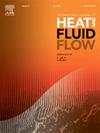Conjugate heat transfer simulation the impact of CMAS non-uniform deposition on the cooling effectiveness of a coated C3X vane
IF 2.6
3区 工程技术
Q2 ENGINEERING, MECHANICAL
International Journal of Heat and Fluid Flow
Pub Date : 2025-01-28
DOI:10.1016/j.ijheatfluidflow.2025.109755
引用次数: 0
Abstract
This study developed a coupled heat transfer and deposit layer dynamic growth model to evaluate the nonuniform deposition behavior of CMAS particles and its impact on the cooling effectiveness of coated C3X high-pressure turbine vanes. Results show that particle accumulation creates protruding deposits at the leading edge and ridge-like deposits at the trailing edge. The low thermal conductivity of TBCs causes the coated vane’s surface temperature and deposit mass to rise significantly, approximately 27.0 K and 47 %, after 9000 h compared to the uncoated vane. Higher deposit surface temperatures increase pressure side temperatures, reducing heat transfer to the vane and lowering internal temperatures. In the absence of deposition, suction side temperatures decrease for both coated and uncoated vanes. Particle impacts increase linearly over time, influenced by diameter, with less effect for particles larger than 11 μm. The coated vane’s higher surface temperature results in a significantly higher particle deposition rate. After 9000 h, deposition efficiency for the coated vane rises from 2.96 % to 4.36 %. As deposition efficiency improves, overall cooling effectiveness increases over time, particularly at the leading and trailing edges, with the average increment rising from 9.4 % to 13 %.
求助全文
约1分钟内获得全文
求助全文
来源期刊

International Journal of Heat and Fluid Flow
工程技术-工程:机械
CiteScore
5.00
自引率
7.70%
发文量
131
审稿时长
33 days
期刊介绍:
The International Journal of Heat and Fluid Flow welcomes high-quality original contributions on experimental, computational, and physical aspects of convective heat transfer and fluid dynamics relevant to engineering or the environment, including multiphase and microscale flows.
Papers reporting the application of these disciplines to design and development, with emphasis on new technological fields, are also welcomed. Some of these new fields include microscale electronic and mechanical systems; medical and biological systems; and thermal and flow control in both the internal and external environment.
 求助内容:
求助内容: 应助结果提醒方式:
应助结果提醒方式:


